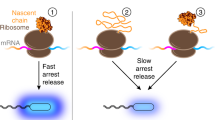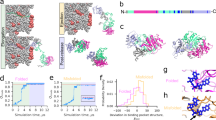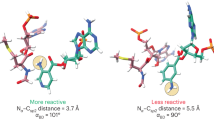Abstract
The chaperonin GroEL has an essential role in mediating protein folding in the cytosol of Escherichia coli. Here we show that GroEL interacts strongly with a well-defined set of approximately 300 newly translated polypeptides, including essential components of the transcription/translation machinery and metabolic enzymes. About one third of these proteins are structurally unstable and repeatedly return to GroEL for conformational maintenance. GroEL substrates consist preferentially of two or more domains with αβ-folds, which contain α-helices and buried β-sheets with extensive hydrophobic surfaces. These proteins are expected to fold slowly and be prone to aggregation. The hydrophobic binding regions of GroEL may be well adapted to interact with the non-native states of αβ-domain proteins.
This is a preview of subscription content, access via your institution
Access options
Subscribe to this journal
Receive 51 print issues and online access
$199.00 per year
only $3.90 per issue
Buy this article
- Purchase on Springer Link
- Instant access to full article PDF
Prices may be subject to local taxes which are calculated during checkout





Similar content being viewed by others
References
Georgopoulos,C. & Welch,W. J. Role of the major heat shock proteins as molecular chaperones. Annu. Rev. Cell Biol. 9, 601–634 (1993).
Ellis,R. J. Roles of molecular chaperones in protein folding. Curr. Opin. Struct. Biol. 4, 117–122 (1994).
Hartl,F. U. Molecular chaperones in cellular protein folding. Nature 381, 571–580 (1996).
Fayet,O., Ziegelhoffer,T. & Georgopoulos,C. The groES and groEL heat shock gene products of Escherichia coli are essential for bacterial growth at all temperatures. J. Bacteriol. 171, 1379–1385 (1989).
Horwich,A. L., Low,K. B., Fenton,W. A., Hirshfield,I. N. & Furtak,K. Folding in vivo of bacterial cytoplasmic proteins: role of GroEL. Cell 74, 909–917 (1993).
Fenton,W. A., Kashi,Y., Furtak,K. & Horwich,A. L. Residues in chaperonin GroEL required for polypeptide binding and release. Nature 371, 614–619 (1994).
Coyle,J. E., Jaeger,J., Gross,M., Robinson,C. V. & Radford,S. E. Structural and mechanistic consequences of polypeptide binding by GroEL. Fold. Design 2, R93–R104 (1997).
Sigler,P. B. et al. Structure and function in GroEL-mediated protein folding. Annu., Rev. Biochem. 67, 581–608 (1998).
Ranson,N. A., White,H. E. & Saibil,H. R. Chaperonins. Biochem. J. 333, 233–242 (1998).
Ewalt,K. L., Hendrick,J. P., Houry,W. A. & Hartl,F. U. In vivo observation of polypeptide flux through the bacterial chaperonin system. Cell 90, 491–500 (1997).
Pedersen,S. Escherichia coli ribosomes translate in vivo with variable rate. EMBO J. 3, 2895–2898 (1984).
Xu,D. & Nussinov,R. Favorable domain size in proteins. Fold. Design 3, 11–17 (1998).
Xu,Z. H., Horwich,A. L. & Sigler,P. B. The crystal structure of the asymmetric GroEL–GroES–(ADP)7 chaperonin complex. Nature 388, 741–750 (1997).
Ellis,R. J. & Hartl,F. U. Protein folding in the cell: Competing models of chaperonin function. FASEB J. 10, 20–26 (1996).
Rye,H. S. et al. GroEL–GroES cycling: ATP and nonnative polypeptide direct alternation of folding-active rings. Cell 97, 325–338 (1999).
Ellis,R. J. Molecular chaperones: avoiding the crowd. Curr. Biol. 7, R531–R533 (1997).
Gentry,D. R. & Burgess,R. R. The cloning and sequence of the gene encoding the omega subunit of Escherichia coli RNA polymerase. Gene 48, 33–40 (1986).
Wada,M., Fujita,H. & Itikawa,H. Genetic suppression of a temperature-sensitive groES mutation by an altered subunit of RNA polymerase of Escherichia coli K-12. J. Bacteriol. 169, 1102–1106 (1987).
Ziemienowicz,A. et al. Both the Escherichia coli chaperone systems, GroEL/GroES and DnaK/DnaJ/GrpE, can reactivate heat-treated RNA polymerase. Different mechanisms for the same activity. J. Biol. Chem. 268, 25425–25431 (1993).
VanBogelen,R. A., Sankar,P., Clark,R. L., Bogan,J. A. & Neidhardt,F. C. The gene–protein database of Escherichia coli: edition 5. Electrophoresis 13, 1014–1054 (1992).
Hubbard,T. J. P., Ailey,B., Brenner,S. E., Murzin,A. G. & Chothia,C. SCOP: a structural classification of proteins database. Nucleic Acids Res. 27, 254–256 (1999).
Orengo,C. A. et al. The CATH database provides insights into protein structure/function relationships. Nucleic Acids Res. 27, 275–279 (1999).
Eisenberg,D., Wilcox,W. & McLachlan,A. D. Hydrophobicity and amphiphilicity in protein structure. J. Cell. Biochem. 31, 11–17 (1986).
Cheng,M. Y. et al. Mitochondrial heat-shock protien hsp60 is essential for assembly of proteins imported into yeast mitochondria. Nature 337, 620–625 (1989).
Rye,H. S. et al. Distinct actions of cis and trans ATP within the double ring of the chaperonin GroEL. Nature 388, 792–798 (1997).
Viitanen,P. V. et al. Chaperonin-facilitated refolding of the ribulsebisphosphate carboxylase and ATP hydrolysis by chaperonin 60 (GroEL) are K+ dependent. Biochemistry 29, 5665–5671 (1990).
Plaxco,K. W., Simons,K. T. & Baker,D. Contact order, transition state placement and the refolding rates of single domain proteins. J. Mol. Biol. 277, 985–994 (1998).
Schlunegger,M. P., Bennett,M. J. & Eisenberg,D. Oligomer formation by 3D domain swapping: a model for protein assembly and misassembly. Adv. Protein Chem. 50, 61–122 (1997).
Landry,S. J., Jordan,R., McMacken,R. & Gierasch,L. M. Different conformations for the same polypeptide bound to chaperones DnaK and GroEL. Nature 355, 455–457 (1992).
Laminet,A. A., Ziegelhoffer,T., Georgopoulos,C. & Pluckthun,A. The Escherichia coli heat shock proteins GroEL and GroES modulate the folding of the beta-lactamase precursor. EMBO J. 9, 2315–2319 (1990).
Vitanen,P. V., Donaldson,G. K., Lorimer,G. H., Lubben,T. H. & Gatenby,A. A. Complex interactions between the chaperonin 60 molecular chaperone and dihydrofolate reductase. Biochemistry 30, 9716–9723 (1991).
Smith,K. E., Voziyan,P. A. & Fisher,M. T. Partitioning of rhodanese onto GroEL–chaperonin binds a reversibly oxidized form derived from the native protein. J. Biol. Chem. 273, 28677–28681 (1998).
Hayer-Hartl,M. K., Weber,F. & Hartl,F. U. Mechanism of chaperonin action: GroES binding and release can drive GroEL-mediated protein folding in the absence of ATP hydrolysis. EMBO J. 15, 6111–6121 (1996).
Bjellqvist,B., Pasquali,C., Ravier,F., Sanchez,J. C. & Hochstrasser,D. A nonlinear wide-range immobilized pH gradient for two-dimensional electrophoresis and its definition in a relevant pH scale. Electrophoresis 14, 1357–1365 (1993).
Gorg,A., Postel,W. & Gunther,S. The current state of two-dimensional electrophoresis with immobilized pH gradients. Electrophoresis 9, 531–546 (1988).
Fountoulakis,M. & Langen,H. Identification of proteins by matrix-assisted laser desorption ionization-mass spectrometry following in-gel digestion in low-salt, nonvolatile buffer and simplified peptide recovery. Anal. Biochem. 250, 153–156 (1997).
Altschul,S. F. et al. Gapped BLAST and PSI-BLAST: a new generation of protein database search programs. Nucleic Acids Res. 25, 3389–3402 (1997).
Wootton,J. & Federhen,S. Statistics of local complexity in amino acid sequences and sequence databases. Comput. Chem. 17, 149–163 (1993).
Labedan,B. & Riley,M. Gene products of Escherichia coli: sequence comparisons and common ancestries. Mol. Biol. Evol. 12, 980–987 (1995).
Klein,P., Kanehisa,M. & DeLisi,C. The detection and classification of membrane-spanning proteins. Biochim. Biophys. Acta 815, 468–476 (1985).
Frishman,D. & Argos,P. Seventy-five percent accuracy in protein secondary structure prediction. Proteins 27, 329–335 (1997).
Nakashima,H., Nishikawa,K. & Ooi,T. The folding type of a protein is relevant to the amino acid composition. J. Biochem. 99, 153–162 (1986).
Huynen,M. et al. Homology-based fold predictions for Mycoplasma genitalium proteins. J. Mol. Biol. 280, 323–326 (1998).
Frishman,D. & Mewes,H. W. Pedantic genome analysis. Trends Genet. 13, 415–416 (1997).
Bairoch,A. & Apweiler,R. The SWISS-PROT protein sequence data bank and its supplement TrEMBL in 1998. Nucleic Acids Res. 26, 38–42 (1998).
Karp,P. D., Riley,M., Paley,S. M., Pellegrini-Toole,A. & Krummenacker,M. EcoCyc: Encyclopedia of Escherichia coli genes and metabolism. Nucleic Acids Res. 26, 50–53 (1998).
Meyer,S. L. Data Analysis for Scientists and Engineers. (Wiley, New York, 1975).
Zhang,G. & Darst,S. A. Structure of the Escherichia coli RNA polymerase alpha subunit amino terminal domain. Science 281, 262–266 (1998).
Nicholls,A., Sharp,K. A. & Honig,B. Protein folding and association: insights from the interfacial and thermodynamic properties of hydrocarbons. Proteins 11, 281–296 (1991).
Acknowledgements
We thank K. Andersson for technical assistance and M. C. Bewley for help with Fig. 5b.
Author information
Authors and Affiliations
Corresponding author
Rights and permissions
About this article
Cite this article
Houry, W., Frishman, D., Eckerskorn, C. et al. Identification of in vivo substrates of the chaperonin GroEL. Nature 402, 147–154 (1999). https://doi.org/10.1038/45977
Received:
Accepted:
Issue Date:
DOI: https://doi.org/10.1038/45977
This article is cited by
-
An inventory of interactors of the human HSP60/HSP10 chaperonin in the mitochondrial matrix space
Cell Stress and Chaperones (2020)
-
Improved 1, 2, 4-butanetriol production from an engineered Escherichia coli by co-expression of different chaperone proteins
World Journal of Microbiology and Biotechnology (2016)
Comments
By submitting a comment you agree to abide by our Terms and Community Guidelines. If you find something abusive or that does not comply with our terms or guidelines please flag it as inappropriate.



